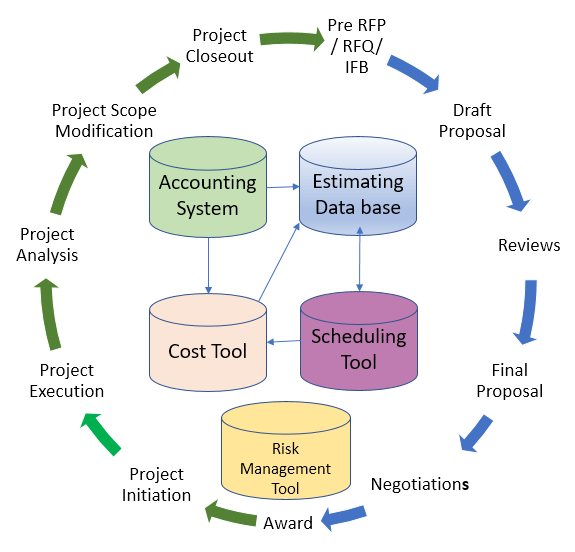
Many companies apply much effort and use many tools for estimating, planning, collecting, and reporting Cost and Resource data.
By Ron Wadlinger
However, many organizations fail to maintain, coordinate, and validate this information to improve the accuracy of future estimates. In fact, there are organizations where there is little or no active coordination of data during the various phases of the lifecycle. In those cases, those organizations are missing out on the opportunity to improve efficiency, and perhaps even win future business.
Below is a review of a typical project procurement and execution lifecycle and with examples of some of the touch points between the key project tools and the estimating system:

Before the Request for Proposal (RFP), Request for Quotation (RFQ), or Invitation for Bid (IFB)
Having accurate cost and resource data and an understanding of that data can be very valuable when deciding to move forward with a proposal. It may even be useful when there is an opportunity to work with the customer to influence the scope of the proposal. Do everything you can to understand your process and your company’s capabilities. It is important to talk to your team, ask questions about how, why, and when things are done. The more you know, the better you can strategize with your team or your clients to find alternate ways to make project estimates work and save on cost and effort.
The use of a standard work breakdown schedule (WBS) and a solid cost, resource, and duration estimating database tool is important in maintaining accurate and up to date data. Typically, these databases contain data that can be used to prepare comparative or parametric estimates.
Review historical data and analyze the information to better refine opportunities or potential risks. By maintaining a good database, you can compare estimates for previous projects against actuals and note where there have been changes to adjust for risks or opportunities. The database should also allow you to note where there where issues in the past and how those issues might have impacted to previous estimates.
Most projects tend to be underestimated. Underestimating a project can result in stress within your organization and a lack of customer confidence when estimated budgets and timelines are not met. It is best when going into a project to have an estimate that is as accurate and realistic as possible. Down the road, you may need to consider taking some estimating risks to be able to win the contract, but those risks should be documented and have a risk mitigation plan should they occur.
Draft Proposal
Upon receipt of the RFP, RFQ, or IFB, it is important to fully understand the scope of the effort. Often there will be a defined statement of work that may even include a WBS provided by the customer. There will likely be a requirement for technical, cost, and schedule details. With a good estimating system in place, it is important to equate the effort required to your standard WBS wherever possible. This will allow you to provide reasonably accurate basis of estimate (BOE) for cost, resources, and schedule durations, and in many cases, the estimating database will include information to support the technical portion of the proposal.
In instances where the scope of work (SOW) is different from the standard type of work you performed in the past, you will likely need to call on subject matter experts (SMEs) to provide estimates based on expert opinion or other analogous estimates based on expert judgement from many sources. In any event, the results of such estimates should be captured and added to the estimating database for future reference.
Most proposals will require at least some type of schedule. Many organizations will simply insert a bar-type Gantt chart using Microsoft Excel, PowerPoint, or Visio. But ideally a company should have a high-level template in a scheduling tool such as Microsoft Project, Primavera, or Open Plan. This allows using the resource and duration data to build out a more realistic schedule. This schedule can then be developed into a more detailed schedule after contract award.
Along with a high-level resource loaded schedule, this data can be loaded into a cost tool such as Deltek Cobra, Ares Prism, MPM, or EVMAX. This cost data can then be developed into more detailed data after contract award.
Review—Preliminary and Formal
In many cases, a proposal will go through many levels of review. During these reviews there may be adjustments to the scope of work, along with adjustments to cost, resources, and schedule durations. It is important to maintain version control on the proposals for use, both during the proposal development effort itself and for future reference to allow the estimating database to be updated.
Proposal effort can often be chaotic, therefore the capturing of critical changes and the reason for those changes may need to be done after the proposal is submitted. Documentation of these changes can often be useful in doing a win/loss analysis.
Final Proposal
After all reviews and approvals, the final proposal or bid is submitted. In some instances, there may be need for further clarification or modification of the proposal. If this happens, you would go through the above steps to address any requests.
Negotiation
Depending on the customer, one or several versions of the proposal may be subject to negotiation. During negotiations, there may be adjustments to the scope of work, along with adjustments to cost, resources, and schedule durations. It is important to maintain version control on the negotiation for use, both during the negotiation effort itself and for future reference to allow the estimating database to be updated.
A good estimating database is valuable during negotiations to ensure that changes consider impacts outside of the points being negotiated. For example, extending the timeframe may impact activities such as project management, financial management, or quality management. On the other hand, “crashing,” or shortening the timeframe may result in the need to perform overtime to perform the work on time. The estimating system should have information that will allow these changes to be fully understood.
Award
When the contract for the project is awarded, the estimate should be frozen as a baseline at award. This can be used to compare against previous baselines as well as a reference point for changes to the estimate during the project phase.
Project Initiation
As the project is initiated, the Project Manager and project team members should use the Baseline Estimate at Award as a starting point for detailed planning and execution of the project plan (Schedule, resource loading, cost calculations, risk calculations, management reserve, etc.)
Since the estimate up to this point was likely created at a high level, it is probable that, as the project is planned in more detail, the estimates (cost, resources, and schedule) will change. There is even a likelihood that there may even be changes in scope of work such as things that will be done in house versus things that will be purchased. The WBS used for the proposal, negotiation, and award may need to be further defined. In some instances, the WBS supplied for the award of the contract may be different than the common WBS used during project execution. In that case, it will be necessary to build a cross reference for the Contract Work Breakdown Structure (CWBS) and the project WBS.
For Earned Value Management (EVM), it will also be necessary to assign an Organization Breakdown Structure (OBS) to the project, and to define Control Accounts (CAs) and Work Packages (WPs) for reporting purposes. The Project Manager will need to assign Control Account Managers (CAMs) and possibly Work Package Managers (WPMs) to be accountable for detail planning and progress reporting on the various control accounts, work packages, and activities. The CAMs should also determine the earned value technique that will be used to calculate earned value.
Specific resources will need to be assigned to the project activities. Depending on staff availability, duration of the work and the cost of the resources assigned to perform the work may cause a variance from the proposal and/or award estimates.
It will also be necessary to work with the accounting system to identify Charge Numbers and labor/cost categories to capture actual expenses.
On completion of project initiation, there should be a resource-loaded, logic-based schedule that is ready for baseline. The schedule, in turn, will be used to load the cost system and there should be a Baseline Cost Estimate. Any changes that occur during project initiation should be used to update the BOE which is maintained in the estimating database.
Project Execution
After the project is baselined, work begins. Project status should be updated in the schedule and cost tools on a regular basis.
Work Authorization Documents (WADs) need to be issued to all resources needed to perform the work. Key data required for the WAD should be available found in the cost system, scheduling tool, or estimating database, or possibly a combination of these systems. Generally, the WAD will specify dates that the work is scheduled to be performed, work to be performed, a detailed list of task outputs, Contract Data Requirements List (CDRL) items, and other task-specific deliverables. It also includes the associated budget for the task and authorizing signatures that confirm that the staff member is authorized to work on the task.
As the work is performed, or items/services are purchased, the schedule progress and completion of tasks, along with any schedule date updates, should be captured on a regular basis (generally monthly, bi-weekly or weekly). This status is then loaded into the scheduling and cost systems.
Actual resource usage, resource cost, quantities of parts or material purchased, purchase cost, subcontract cost etc. are captured in the accounting system. This data is then loaded into the cost tool for analysis, typically on a monthly basis.
Project Modification
Occasionally, the customer may request scope changes to the project, usually through at contract modification, this also could be requested through a process considered to be authorized unpriced work. If these modifications result in a change in cost or schedule duration, the changes should be documented using a Baseline Change Request (BCR) process. The outcome of any BCR should be relayed to the estimating team to be used to review the values in the estimating tool.
In some organizations, internal BCRs may also be made at the discretion of management. This may happen to deal with risk mitigation using Management Reserve (MR), or for other reasons. If these modifications result in a change in cost or schedule duration, the changes should be documented using a BCR process. The outcome of any internal BCR should be relayed to the estimating team to be used to review the values in the estimating tool.
Project Closeout
At the end of the project, the Project Manager should review the history of the project and provide a full analysis of what went well and what went poorly. The actual outcome, cost, schedule, scope, quality, and resource utilization should be reviewed and reported on to management. Lessons learned for improvement should also be captured. This data should be relayed to the estimating team, along with the final actual data, for inclusion in the estimating tool.
In Summary
Many projects tend to be long term. The Project Management Institute (PMI) defines a project as follows: “A temporary endeavor undertaken to create a unique product or service.”
Since most projects are unique, performing estimates is not an exact science, but one that must consider many datapoints. The better the information going into the estimate, the better the result.
Experience has shown that most organizations do not do a good job in estimating and project management. A 2011 study by Harvard Business Review[1] found, based on a study of 1,471 information technology (IT) change initiative projects, the average cost overrun was 27%, but one in six projects had a cost overrun of 200%, on average, and a schedule overrun of 70%. While these numbers seem improbable, there are many accounts and studies of this happening in all industries.
This reinforces the need for companies to implement good process and procedures that start with estimating and move into project management, risk management, and project forecasting and project controls.
Realizing that you cannot just start with a number that worked in the past and throw it over the wall to the project team after contract award is not good enough. Instead it is worth the effort to integrate the full suite of tools including estimating, scheduling, cost, accounting, and risk management.
If you’re building a team and you have positions you can’t fill, you need to use SMA Talent on Demand (TOD®)! With TOD®, you can find experienced talent, such as Ron, matched to your exact needs:
[1] Why Your IT Project May Be Riskier Than You Think, Bent Flyvbjerg and Alexander Budzier, Harvard Business Review, September 2011, retrieved from https://hbr.org/2011/09/why-your-it-project-may-be-riskier-than-you-think
